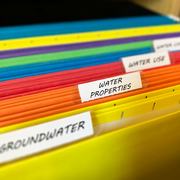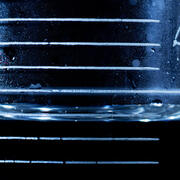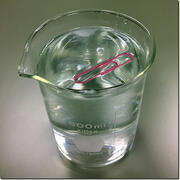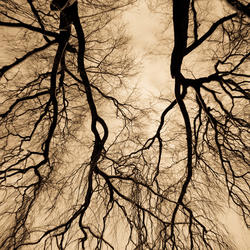Adhesion and cohesion are important water properties that affects how water works everywhere, from plant leaves to your own body. Just remember... Cohesion: Water is attracted to water, and Adhesion: Water is attracted to other substances.
• Water Science School HOME • Water Properties topics •

I used to wake up in a cold sweat because I could not get the concepts of water adhesion and cohesion clear in my mind. If you have that problem, too, then read on to learn about these important properties of water...
Cohesion: Water is attracted to water
Adhesion: Water is attracted to other substances
Adhesion and cohesion are water properties that affect every water molecule on Earth and also the interaction of water molecules with molecules of other substances. Essentially, cohesion and adhesion are the "stickiness" that water molecules have for each other and for other substances.
A water drop is composed of water molecules that like to stick together-an example of the property of cohesion. In the picture of pine needles above, the water droplets are stuck to the end of the pine needles-an example of the property of adhesion. Also noticeable in this picture is the effect that gravity has on the water drops. Gravity is working against both adhesion and cohesion, trying to pull the water drop downward. Adhesion and cohesion are winning the battle so far, as the drops are sticking to the pine needles.
Cohesion makes a water drop a drop
If you just look at the picture of the water drop sitting of the leaf, you might think the water drop has a "skin" holding it into a sort of flattened sphere (although there is nothing flat about a water drop in outer space). It turns out that this surface tension is the result of the tendency of water molecules to attract one another. The natural form of a water drop occurs during the "lowest energy state", the state where the atoms in the molecule are using the least amount of energy. For water, this state happens when a water molecule is surrounded on all sides by other water molecules, which creates a sphere or ball (perfectly round if it was in outer space). On Earth, the effect of gravity flattens this ideal sphere into the drop shape we see. Although you may have heard of a "skin" where water meets the air, this is not really an accurate description, as there is nothing other than water in the drop.

Credit: Ashley Estrella: https://www.pexels.com/photo/close-up-photo-of-water-drops-220859/
What is the shape of a raindrop? Are they really tear-shaped?
Maybe not. Find out here.
Why is water sticky?
Water is highly cohesive—it is the highest of the non-metallic liquids. Water is sticky and clumps together into drops because of its cohesive properties, but chemistry and electricity are involved at a more detailed level to make this possible. More precisely, the positive and negative charges of the hydrogen and oxygen atoms that make up water molecules makes them attracted to each other. If you've played with bar magnets you will know that the north pole of one magnet will repel the north pole of another magnet, but it will attract the south pole of another magnet. Opposite magnetic poles attract one another much like positively charged atoms attract negatively charged atoms in water molecules.
Molecular layout of liquid water molecules
In a water molecule, the two hydrogen atoms align themselves along one side of the oxygen atom, with the result being that the oxygen side has a partial negative charge and the side with the hydrogen atoms has a partial positive charge. Thus when the positive side on one water molecule comes near the negative side of another water molecule, they attract each other and form a bond. This "bipolar" nature of water molecules gives water its cohesive nature, and thus, its stickiness and clumpability (maybe "dropability" is a better term?).

Learn more about adhesion, cohesion, and other water properties.
Water Properties Information by Topic
Water Meniscus
Surface Tension and Water
Water in Space: How Does Water Behave in Outer Space?
Water Properties True/False Quiz
Capillary Action and Water
Images and other multimedia resources about adhesion, cohesion, and other water properties.
Adhesion and cohesion are important water properties that affects how water works everywhere, from plant leaves to your own body. Just remember... Cohesion: Water is attracted to water, and Adhesion: Water is attracted to other substances.
• Water Science School HOME • Water Properties topics •

I used to wake up in a cold sweat because I could not get the concepts of water adhesion and cohesion clear in my mind. If you have that problem, too, then read on to learn about these important properties of water...
Cohesion: Water is attracted to water
Adhesion: Water is attracted to other substances
Adhesion and cohesion are water properties that affect every water molecule on Earth and also the interaction of water molecules with molecules of other substances. Essentially, cohesion and adhesion are the "stickiness" that water molecules have for each other and for other substances.
A water drop is composed of water molecules that like to stick together-an example of the property of cohesion. In the picture of pine needles above, the water droplets are stuck to the end of the pine needles-an example of the property of adhesion. Also noticeable in this picture is the effect that gravity has on the water drops. Gravity is working against both adhesion and cohesion, trying to pull the water drop downward. Adhesion and cohesion are winning the battle so far, as the drops are sticking to the pine needles.
Cohesion makes a water drop a drop
If you just look at the picture of the water drop sitting of the leaf, you might think the water drop has a "skin" holding it into a sort of flattened sphere (although there is nothing flat about a water drop in outer space). It turns out that this surface tension is the result of the tendency of water molecules to attract one another. The natural form of a water drop occurs during the "lowest energy state", the state where the atoms in the molecule are using the least amount of energy. For water, this state happens when a water molecule is surrounded on all sides by other water molecules, which creates a sphere or ball (perfectly round if it was in outer space). On Earth, the effect of gravity flattens this ideal sphere into the drop shape we see. Although you may have heard of a "skin" where water meets the air, this is not really an accurate description, as there is nothing other than water in the drop.

Credit: Ashley Estrella: https://www.pexels.com/photo/close-up-photo-of-water-drops-220859/
What is the shape of a raindrop? Are they really tear-shaped?
Maybe not. Find out here.
Why is water sticky?
Water is highly cohesive—it is the highest of the non-metallic liquids. Water is sticky and clumps together into drops because of its cohesive properties, but chemistry and electricity are involved at a more detailed level to make this possible. More precisely, the positive and negative charges of the hydrogen and oxygen atoms that make up water molecules makes them attracted to each other. If you've played with bar magnets you will know that the north pole of one magnet will repel the north pole of another magnet, but it will attract the south pole of another magnet. Opposite magnetic poles attract one another much like positively charged atoms attract negatively charged atoms in water molecules.
Molecular layout of liquid water molecules
In a water molecule, the two hydrogen atoms align themselves along one side of the oxygen atom, with the result being that the oxygen side has a partial negative charge and the side with the hydrogen atoms has a partial positive charge. Thus when the positive side on one water molecule comes near the negative side of another water molecule, they attract each other and form a bond. This "bipolar" nature of water molecules gives water its cohesive nature, and thus, its stickiness and clumpability (maybe "dropability" is a better term?).

Learn more about adhesion, cohesion, and other water properties.
Water Properties Information by Topic
Water Meniscus
Surface Tension and Water
Water in Space: How Does Water Behave in Outer Space?
Water Properties True/False Quiz
Capillary Action and Water
Images and other multimedia resources about adhesion, cohesion, and other water properties.







